Big Picture Event Storming: Simple Workshops, Big Benefits for Your Business
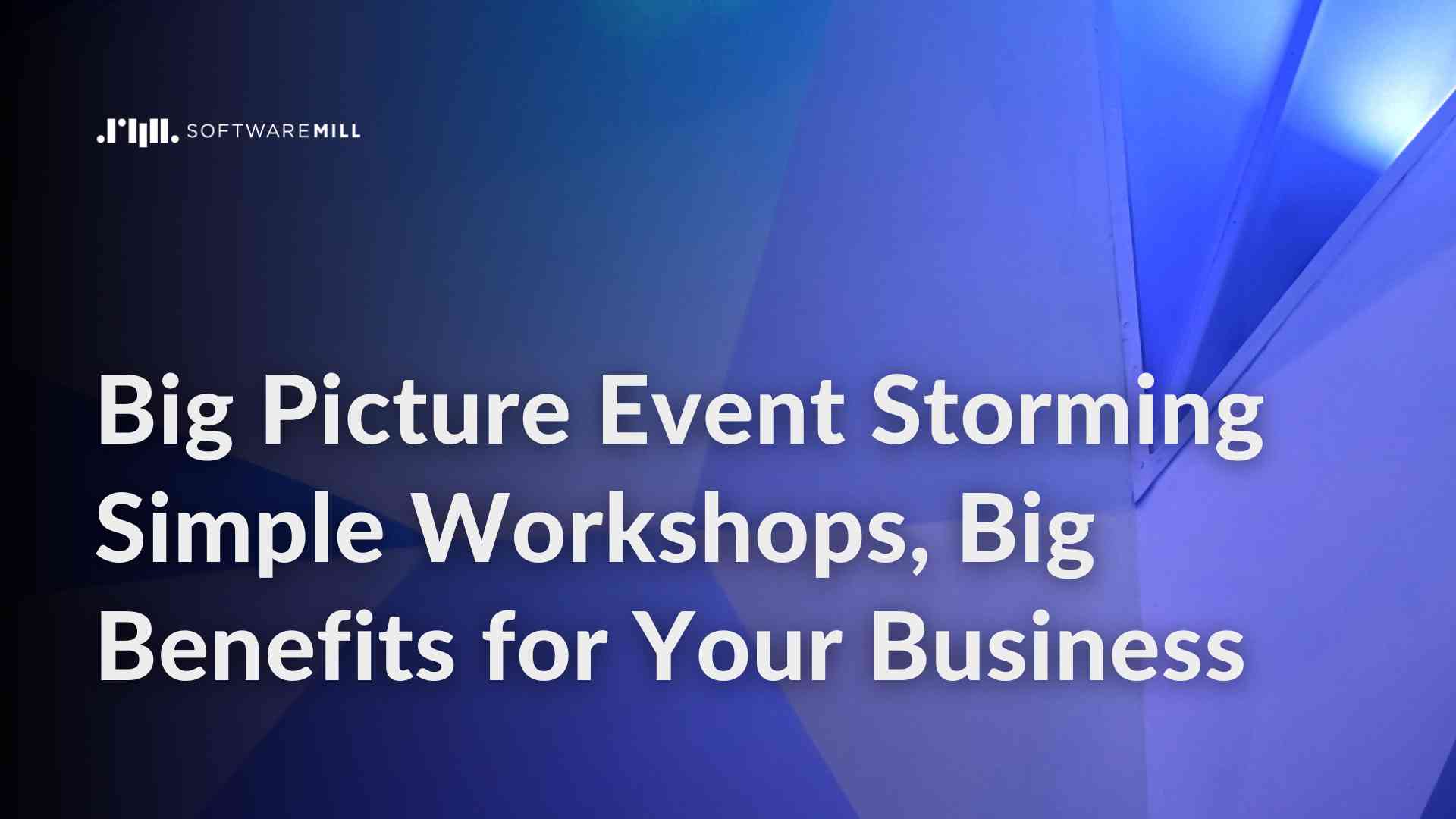
As part of our initiative to share knowledge about Domain Driven Design and related tools - I would like to tell you about one of the interesting workshops we use in our clients' projects. It is called the Big Picture Event Storming workshop, which leads to the discovery of relevant business events across the timeline.
Since this workshop is strongly related to business processes around its core domains, I will explain its business benefits and won't focus on the technical details of conducting such workshops.
You will learn what workshop goals you can set and which needs of your company they will meet. I will explain where those benefits come from, for example, what risks a workshop will reduce while starting or extending your projects or digital products.
Check all the articles from the series:
- Domain Driven Design: A SoftwareMill Way
- Mastering Chaos with Big Picture Event Storming
- Finding the Gaps with Big Picture Event Storming
- Event Storming from a non-technical domain expert perspective
- Big Picture Event Storming: Simple Workshops, Big Benefits for Your Business
- Managing complexity and uncertainty in Software Development: know when to press pause
- Remote Event Storming challenges from a facilitator's perspective
Real Benefits in Your Business
In the dynamic and constantly changing environment, the ability to effectively adapt our business quickly is crucial. In the short term, we need to be able to analyze and react to changes quickly. At the workshop, we discovered business processes that are as close to the truth as possible, with a high probability of seeing an accurate picture.
Long-term, on the other hand, innovation, cost, and risk optimization are important to us. Event Storming can support you in each of these dimensions, providing your company with a competitive advantage. Imagine that most companies may be unaware that their business processes contain inefficient or redundant steps, resulting in higher operating costs.
By bringing the workshop up to speed, it has the effect of accelerating value delivery. Planning and implementing a project is more efficient when essential requirements and business processes are transparent and understood from the start.
Also, customers and other users may be more satisfied with the optimal paths through the project, e.g. shopping paths in online stores. This translates indirectly into their engagement and attachment.
It is also worth mentioning the internal benefits - strengthening cooperation between teams. Speaking a common language, with increased mutual understanding, teams from different departments of a company communicate more effectively. It is the view of business processes from outside their local "bubble" that allows employees to understand each other better. It also fosters joint integration despite differences, thus contributing to a friendly work environment.
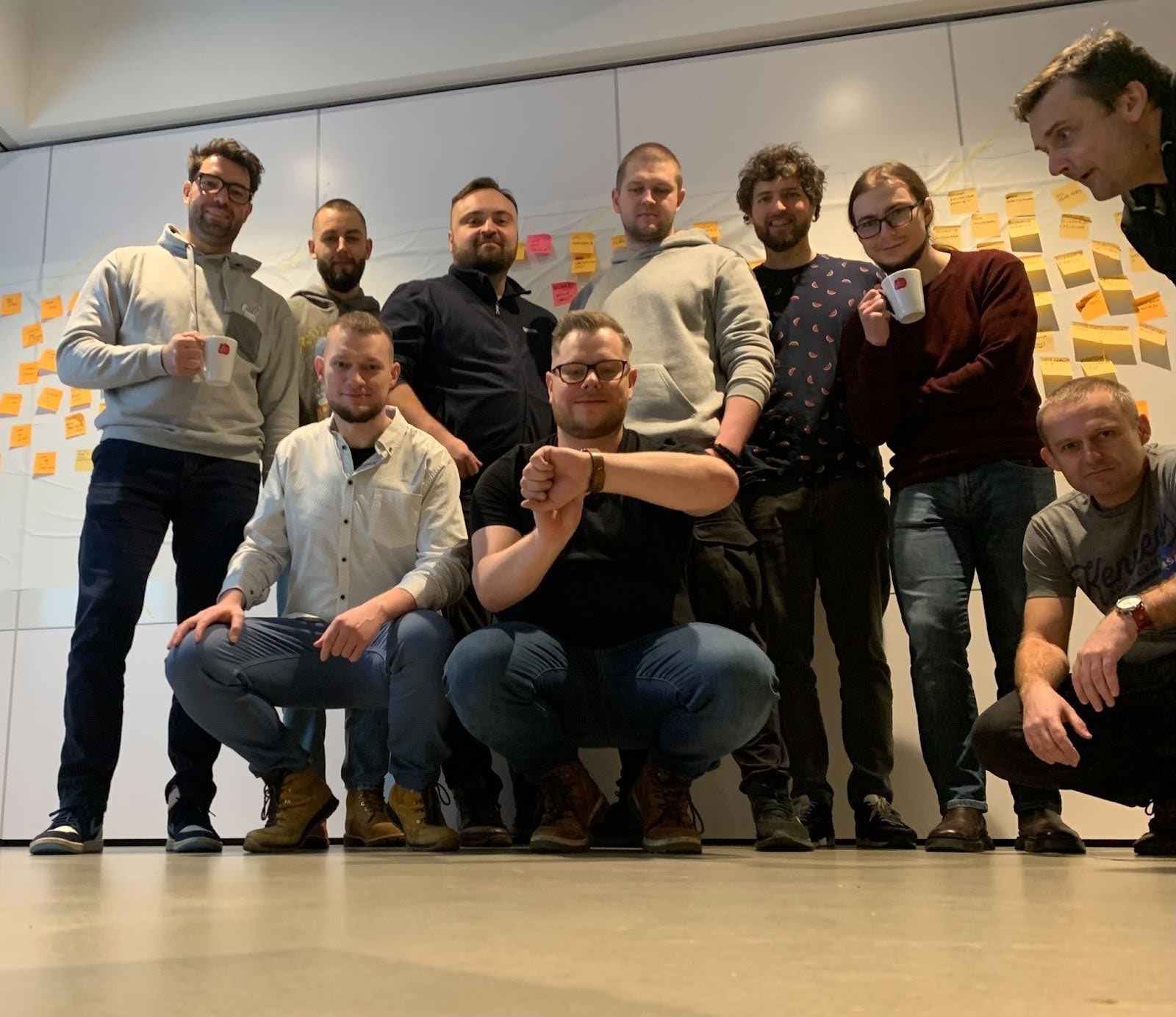
Workshops are also about strengthening integration.
It's not just IT projects. The Big Picture Event Storming can analyze and discover more "physical" processes. For example, for structuring work across various roles, organization of events, marketing campaigns, conferences, and presentations - both recurring and one-off.
The result of the workshop, or more specifically, business events over time, can serve as potential metrics to help track progress and company performance in various areas. Imagine you are the owner of an online store. You see a dashboard with the number of orders per day, you can track the number of invoices processed by the accounting department, etc. Each of these numbers is the sum of business-relevant events of one type in a given interval of time. When you make changes to your business, you will be able to compare the current value of the metric with the value before the changes were made. This allows you to measure whether the change had the desired effect, e.g., a new marketing campaign.
Having information on who (like actor, user, or employee) is the author of the event allows you to determine the responsibilities of roles and users in the context of the analyzed project.
One workshop, many goals to achieve
In practice, the artifacts we have obtained from the workshop also contain information valuable in various dimensions of knowledge, so we can achieve more goals in the process than we originally intended.
Of course, our goal is not to conduct a workshop itself. It is important to take one main goal that we care most about. This is mainly based on our needs.
Below, you will learn a list of the 8 most common Event Storming objectives oriented to meet different needs from the business side.
- Discovering and understanding reality, so-called “AS-IS” - focuses on understanding existing business processes, whether they are part of the system or not, without making changes. Especially in areas that are unclear, problematic, and costly. This helps identify "bottlenecks" and potential areas for optimization. A picture of what the system looks like - even if the individual steps are convoluted and complicated. This is also valuable information for new company employees and potential engineers who will maintain or develop the project. This significantly reduces the onboarding time for new people.
- Rapid and consistent modeling of future processes, so-called “TO-BE” - it can be a fragment of a system or even a whole system. The focus is on changes or a new form of business processes that are consistent, understandable, optimal, and often innovative. It is a picture of the processes we ultimately want to have in the system - consistent with the common point of view of many different stakeholders. It significantly reduces the risk of misunderstandings, the so-called "deaf phone" between businesses and engineers. It provides a solid basis for engineers to estimate work accurately and verify it by the business side after the project is completed.
- Startup/New Project validation - it’s the variation of the previous point “TO-BE”, but for non-existing projects. When it comes to ideas for potential products, business models, and startups - we can try to model their processes to validate them. By validation, I mostly mean checking if building a profitable business that meets your customer's needs makes sense. We’ll identify places that will increase your income, but on the other hand, deliver value for the potential customers. In addition, we’ll check if it’s even possible to implement it. Discovering and resolving unclear or unknown areas of business processes helps with that. In the end, we can narrow the scope of an MVP. Optionally, we can use the produced artifacts to provide rough estimations of how long it will take to implement this project.
- Development of a common point of view - helps build common understanding and vocabulary in business and project teams. This is crucial for effective communication and collaboration. We achieve this through simple notation based on cards, kept in 1 place, and seen by all workshop participants in the same way. Here we avoid a situation where each participant would have separate notes on paper. Those notes may be different and inconsistent images of the knowledge gained at the workshop.
- Identification of possible improvements - By analyzing the current state of processes and systems, we find places that can be simplified, streamlined, or even removed, if redundant. This may lead to cost savings and increased productivity. For example, we can identify places to implement AI algorithms that will automate manual work done by humans.
- Improving User Experience - for both the system's customers and the company's employees like the support department. By analyzing business processes from the point of view of the people who use the system, we can find places that can be shortened so that ultimately the steps take less time to go through and increase satisfaction. You can also use this information to increase customer engagement by focusing on opportunities rather than threats.
- Introducing innovation - Event Storming can inspire us to think creatively and help generate new ideas for products/services that the market needs. It helps you find your USP (Unique Selling Proposition). It's a great way to create business processes, something that no one has brought to market before. Often, there is no way to learn this new area from books, or materials with ready-made recipes as they may not exist yet.
- Systems integrations - Especially in large ecosystems, analyzing the business processes helps us to better understand how to integrate them, filter out unnecessary information, and identify potential problems and inaccuracies. After the workshop, project teams adjust their APIs to achieve smoother integration.
Breaking it down. What is there to do and why?
Before I get started to explain where the pointed-out benefits come from, let me tell you a little story. It will narrow us down to the scenarios in which the workshops usually occur.
Imagine starting a new venture following your business strategy. A technology project, opening a new department in your company, or maybe even organizing an event or conference.
You have already hired employees and started to organize the work around the project. Moving between an ambitious business idea's inception and execution involves a deep dive into the initiative. Where to start? What to do first? Those questions mostly depend on the picture of business processes you want to have inside your project. You need to know what will happen step by step while using your product.
Going further, let's say this specific project is a web application with a minimal set of features, that will execute steps of desired business processes. Usually, you have in mind relevant events which occur within them. For instance:
- Invoice was created
- Item added to shopping cart
- Order paid
Those events are the essential building blocks of processes we want to explore.
In conclusion, it is necessary to discover what business events we need and the reasons why they’re needed. This will determine the business value that a piece of the project will deliver to stakeholders, both owners and customers. Therefore, the Big Picture Event Storming leads to the discovery of relevant business events across the timeline. In the end, groups of those events will be an essential part of the processes within your project.
When fundamental questions arise
During the workshop phases, we will resolve the most fundamental questions like:
- Who will use this specific feature?
- Who will have access to it?
- When will the action happen?
- In what order do events happen?
It would be rather an easy task because we can fetch that information from the sticky notes notation of the workshop itself. For instance, we will have cards that visualize specific Actors close to relevant business event cards. By Actor, I mean a user who can trigger an action. Such information is explicitly visible on the Event Storming board.
Without information about business processes, it will be challenging to build the product. This area, "invisible" at first glance, is essential to the project from the beginning to the very end of the work, including later maintenance.
Suppose we bypass the process of discovering and modeling business processes. In that case, the responsibility for their picture and, therefore, for the project's success in practice is often pushed onto engineers. Engineers may be, for instance, part of a technical team in an IT project. Nevertheless, the shape of processes represents a set of decisions made by the business. It is, therefore, not a matter of engineers' decisions.
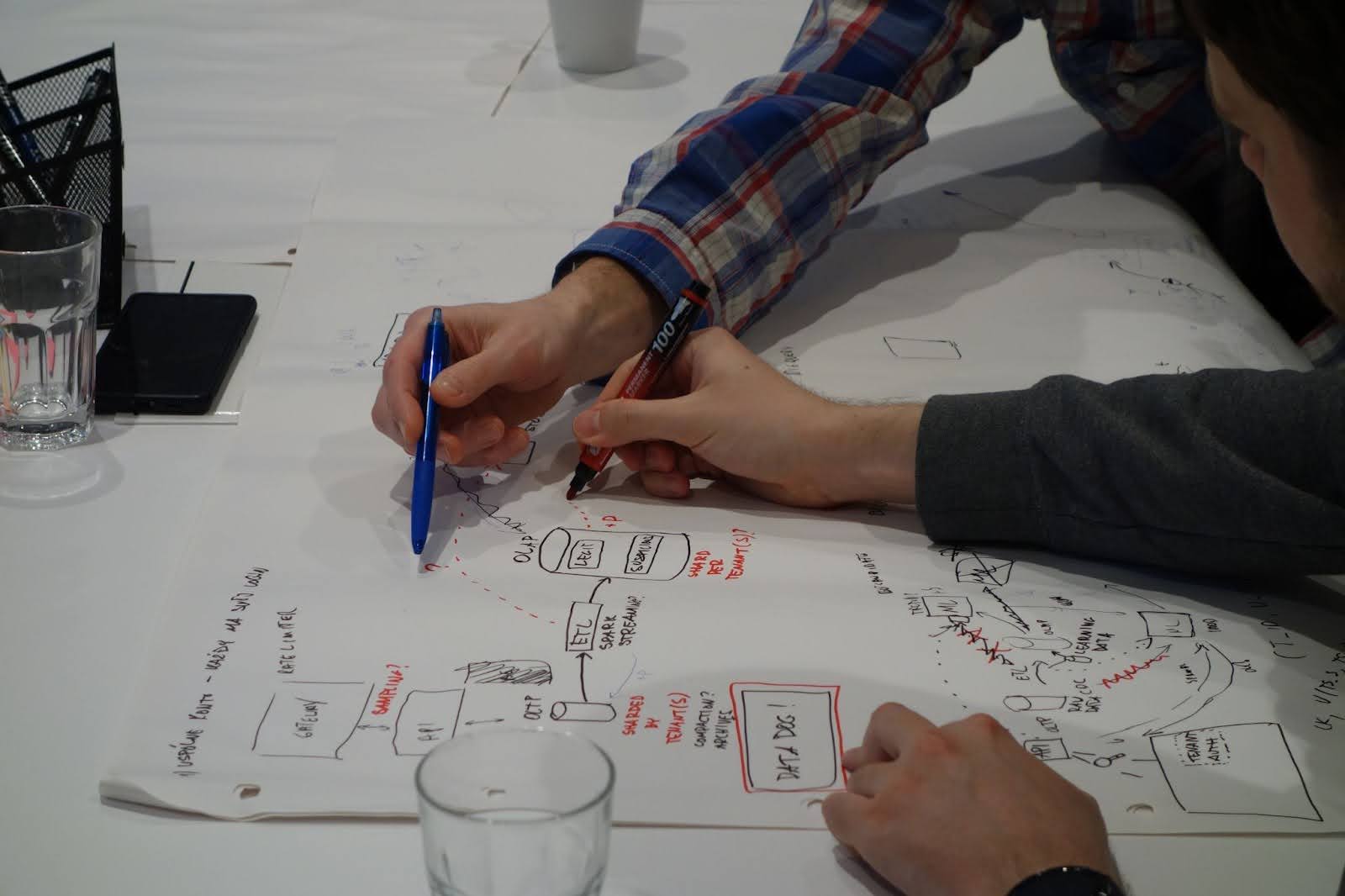
The new challenges require modeling before going into technical details.
Commonly, we can't get away with modeling. If we don't do it at the beginning, we'll have to do it anyway later, during the work of building the project. In practice, the later we do it, the greater the risk of failure we create, especially in terms of higher costs of making changes to our project. What kind of failures do we have in mind? For instance, you will have developed features, which don't fit reality and your customers’ needs. They can contain unnecessary steps, gather data that is not relevant, and even block the users from achieving their goals. As we can imagine, the modeling touches on areas that are important from the perspective of your customers, users, partners, strategy, and vision.
Letting engineers decide how entire processes will look is not a good idea. You and your company's employees are the ones who know best what they look or should look like from the inside. The people who know their area of operation well and who may be affected by this project. As representatives of such knowledge, they are called "domain experts." They are almost always from within the company, exceptions are tax consultants, accountants, lawyers, and so on.
Also, keep in mind that sometimes domain experts may not have sufficient knowledge of these processes. Some of these details may already be forgotten, remain in the minds of former employees, or are not well defined. And this is perfectly fine. It's nothing to be ashamed of, and knowing that we don't know something is even necessary.
Awareness of both dimensions, that is, the process areas we know and the areas we don't know, minimizes the risk of failure in terms of project development. Based on that knowledge, important current and future decisions about the project are often made. We know what’s possible to achieve, and what’s probably not. It could lead to cost-effective development, thanks to fewer misunderstandings throughout the cooperation.
You're probably asking yourself now: if the knowledge is in our heads, how can it be extracted? Ideally, it should have a coherent message, it can be visualized both simply and clearly without misunderstandings, and it can be confidently communicated to the engineers so that they know exactly what to do, and in what order. The question of "how" to do it will be handled by them - they are specialists.
Bridge the gap between your strategy and project development
A topic that will help you do just that is the Big Picture Event Storming workshop. It is the bridge between your business strategy and building your digital project.
Although this method is simple and cost-effective, it provides clear insights into operational processes. You discover what is being run, why, in what order, and who can use which features.
Let’s discuss a carved-out range of features of the Event Storming workshop relevant from a business perspective:
- The simplicity lies in operating on sticky notes, where we gradually increase the color palette of cards. Each participant is not overwhelmed by too much information to start. This allows you to quickly understand the principles of this workshop, thanks to the low entry threshold. No one will feel bad about it, not mentally burdened will overcome the fear of trying this technique.
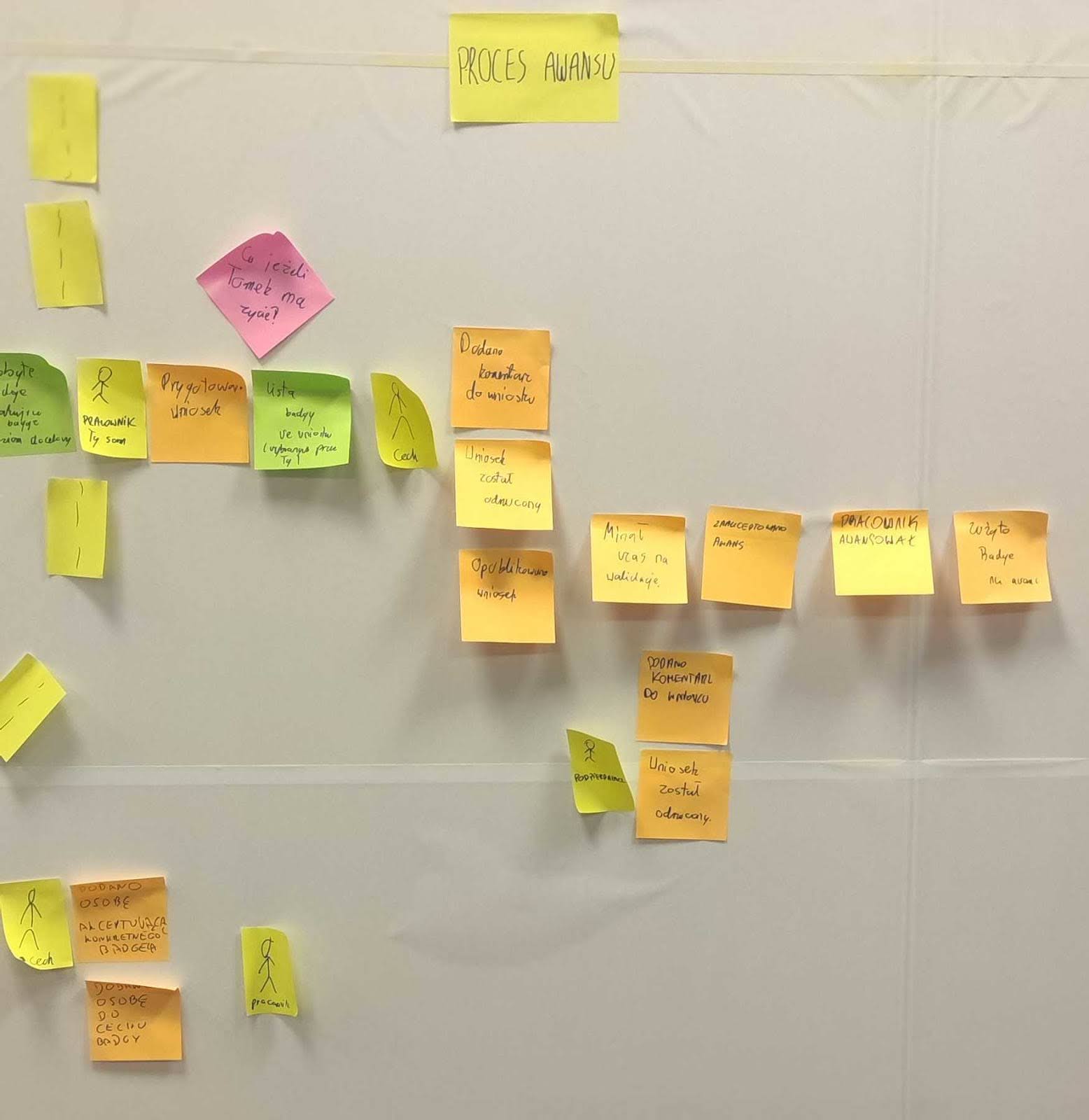
The simplicity lies in the sticky note notation.
- Affordable adjustments - this refers to the ability to fast and easily modify our understanding and model of the business processes we're exploring. Imagine how long a process change would take if you already had a project built whether it is a house or an IT product. Depending on how many factors are affected by the change, it could even take weeks of waiting. You can compare it to having a team of engineers demolish a wall in an already-built house and brick a new one elsewhere. When you change a model during an Event Storming session, you simply move stickies around, remove or rename existing ones, and crumble the ones that are no longer necessary. How long does it take? Just a few seconds instead of a couple of weeks of work.
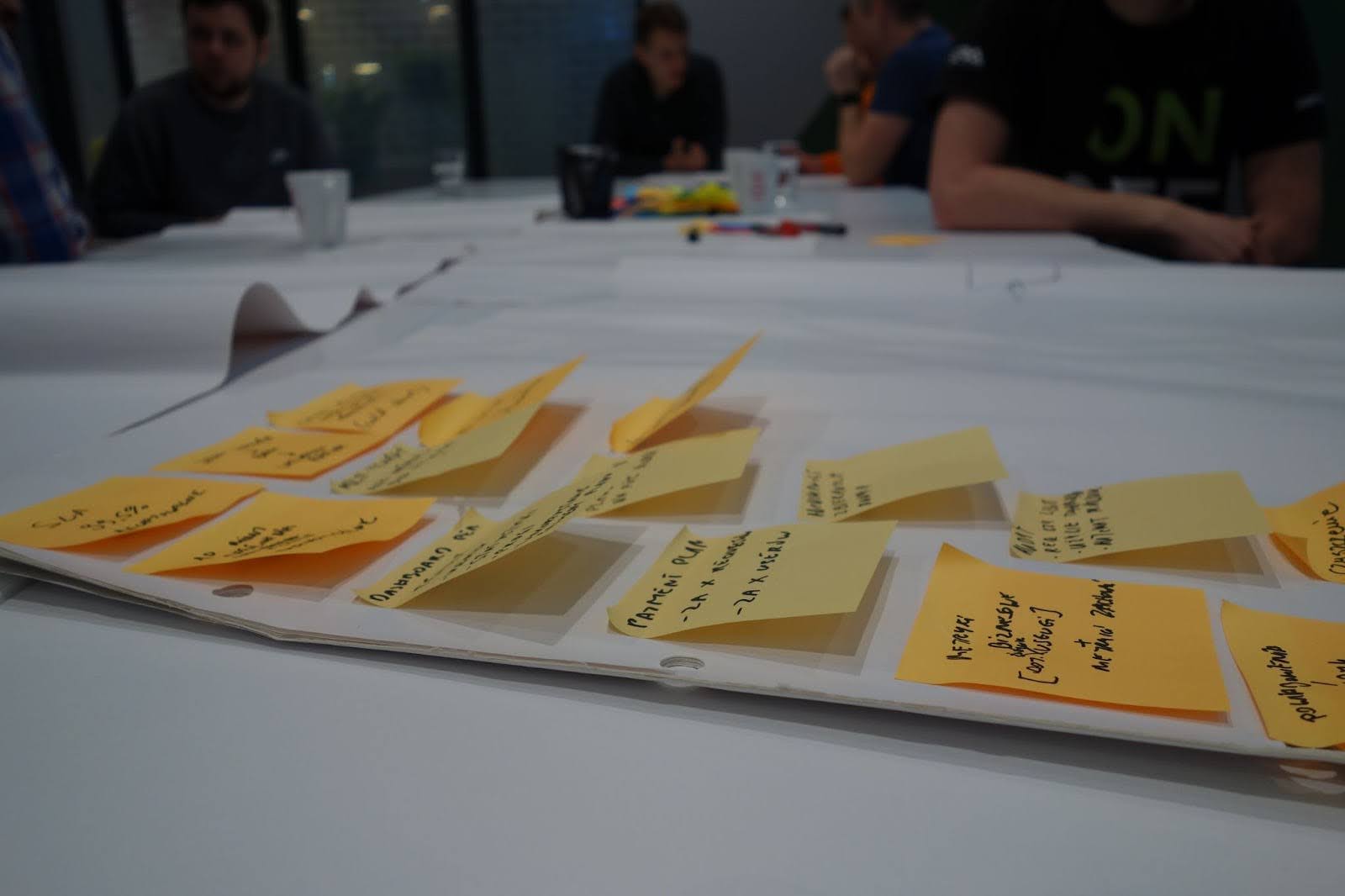
Rejected events at process changes. Took seconds to move cards.
- The workshop is quick, usually taking 2 to 3 days at 4 hours a day. This is an important feature compared to other types of product analysis, such as corporate "waterfall", which takes many weeks and sometimes months.
It is worth noting that the workshop's so-called "Big Picture" takes care of the overall picture of the processes, where we focus on discovering them holistically. The most important information for decision-making is mostly already extracted.
If you are interested in how exactly this workshop is performed and what are its principles of operation, then you can check out the dedicated blog post describing this process.
What Event Storming is not?
Stakeholders may come from diverse backgrounds with varying expectations and perceptions of the workshop. Although it is a great tool for visualizing and understanding business processes, it can also be over-interpreted or misperceived.
Therefore, it is important to say what Event Storming is not:
- Ready-made project documentation - is not a substitute for detailed technical documentation, i.e., architecture sketches, infrastructure, or UML code. We are not dealing here with the technical "how", but with the business "what".
- Project management and its task list - this is no longer the responsibility of the workshop. Of course, it is possible to map the initial User Stories, in terms of use scenarios and acceptance criteria, based on the artifacts after the workshop. However, this mapping requires additional work.
- A user interface (UI) design tool - even though there may be elements of a data model, such as so-called "views," in it.
- A technical data model - does not describe schemas, the type of databases, or their implementation.
- Limited to large organizations only - it doesn't matter how large and complex your project is. It will work equally well for small teams and startups.
- Not a substitute for direct communication - changing requirements and business environments over time still require adjustments, adaptation, and dialogue. On the plus side, the workshop can be repeated multiple times to make adaptations faster.
I want to try it! What's next?
At SoftwareMill we have experience in Event Storming workshops for institutional clients and startups both remote and onsite.
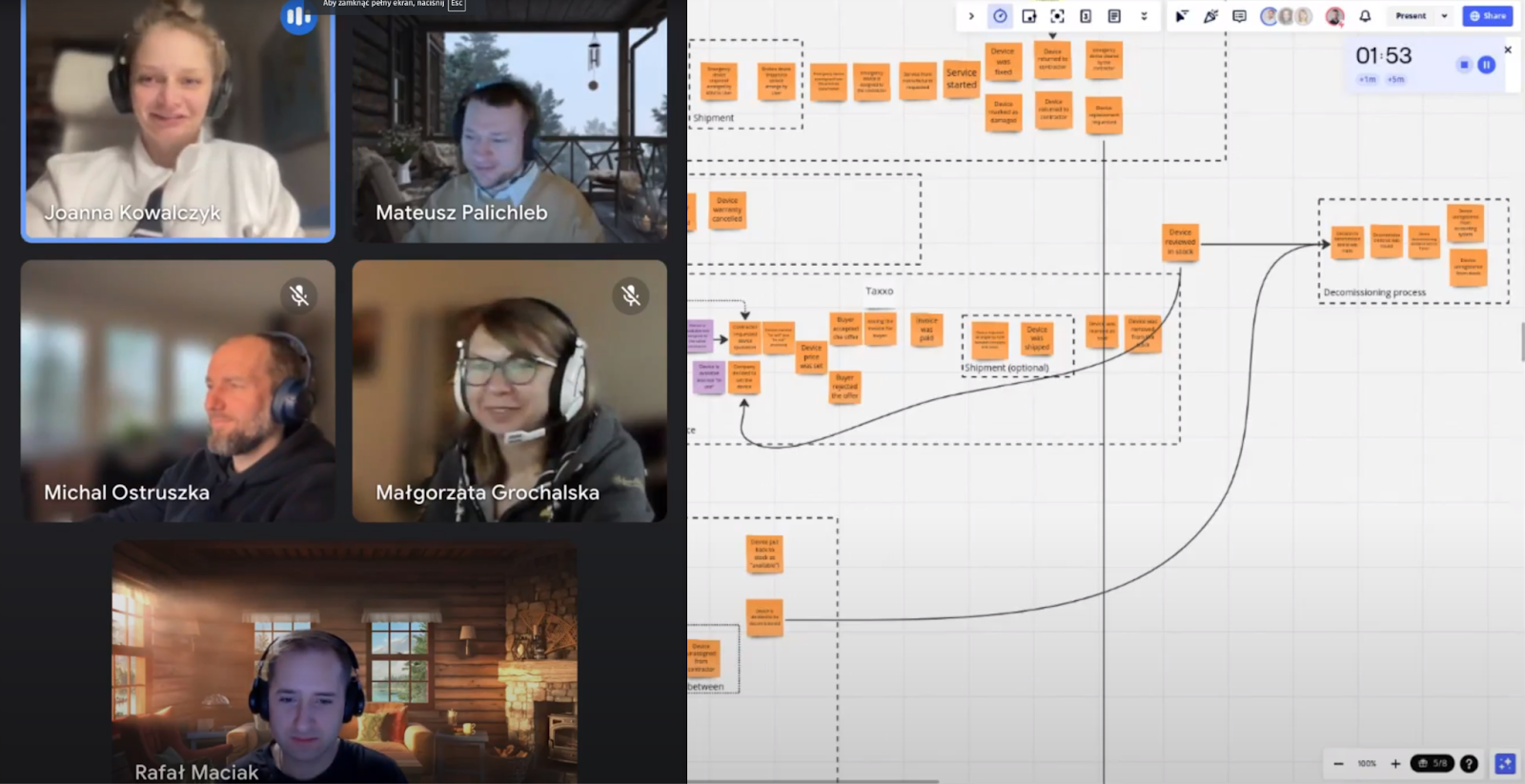
A remote workshop session using the Miro app, among others.
Ask yourself, what is your goal? The list of goals presented in the previous paragraphs will help you. Choose the one that will benefit you the most.
If you have answered this question for yourself, contact us! We will organize and conduct a workshop for you. We will gradually and stress-freely guide you through the world of Event Storming for you and other participants.
Still not convinced? Check out our blog posts under the "Event Storming" tag to learn more.
Check all the articles from the series:
- Domain Driven Design: A SoftwareMill Way
- Mastering Chaos with Big Picture Event Storming
- Finding the Gaps with Big Picture Event Storming
- Event Storming from a non-technical domain expert perspective
- Big Picture Event Storming: Simple Workshops, Big Benefits for Your Business
- Managing complexity and uncertainty in Software Development: know when to press pause
- Remote Event Storming challenges from a facilitator's perspective
Reviewed by: Rafał Maciak, Michał Ostruszka, Maria Kucharczyk